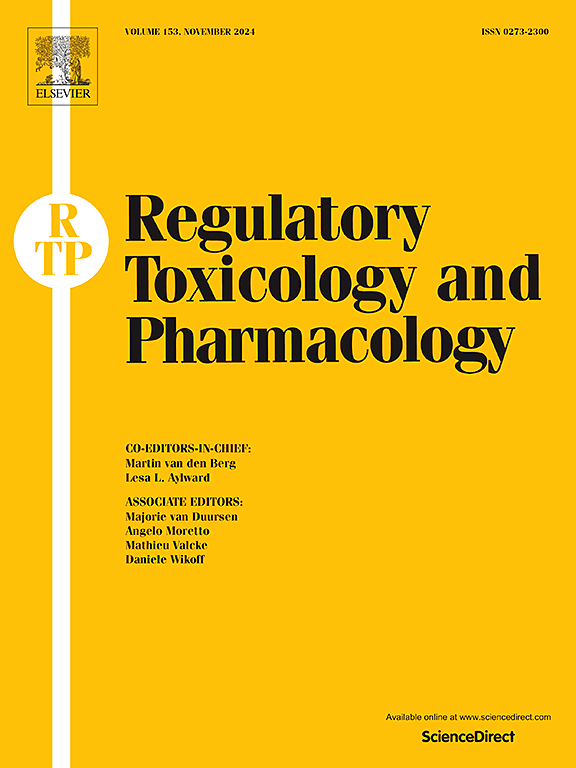通过改良欧文试验对 Sprague-Dawley 大鼠进行 BMEDA 神经行为评估。
IF 3
4区 医学
Q1 MEDICINE, LEGAL
引用次数: 0
摘要
N,N-双(2-巯基乙醇)-N',N'-二乙二胺(BMEDA)可与铼-188(188Re)形成螯合物,生成188Re-BMEDA-脂质体,本研究对BMEDA的神经行为评估进行了评估。本研究的目的是采用功能观察电池观察程序,评估 Sprague-Dawley 大鼠静脉注射 BMEDA 后可能出现的神经行为变化。给大鼠注射的 BMEDA 剂量分别为 1、2 和 5 毫克/千克。未观察到大鼠死亡。在剂量为 5 毫克/千克的剂量组中,用药后 10 分钟观察到一些与 BMEDA 治疗相关的现象。1 只雄性大鼠和 7 只雌性大鼠出现震颤。在雄性和雌性大鼠中均观察到呼吸加快、发声、不易操控和/或肢体失去张力,在雄性大鼠中观察到体温升高。根据研究结果,给大鼠静脉注射单剂量的 BMEDA,当剂量为 5 毫克/千克时,会导致呼吸加快、发声、不易操控和/或肢体张力减弱。给大鼠注射 2 毫克/千克剂量的 BMEDA 后,未发现神经行为方面的影响。这项研究的信息将为今后设计适当的治疗研究提供参考。本文章由计算机程序翻译,如有差异,请以英文原文为准。
Neurobehavioral assessment of BMEDA by modified Irwin test in Sprague-Dawley rats
The neurobehavioral assessment of N,N-bis(2-mercapatoethly)-N′,N′-diethylenediamine (BMEDA), which can form a chelate with rhenium-188 (188Re) to produce the 188Re-BMEDA-liposome, was evaluated. The purpose of this study was to evaluate the potential neurobehavioral changes by using the functional observational battery observation procedures when intravenous injection of BMEDA to Sprague-Dawley rats. Rats were administered BMEDA at dose levels of 1, 2, and 5 mg/kg. No mortalities were observed. There are some observations related to BMEDA treatment found in the 5 mg/kg dose group at 10 min post-dose. Tremor was observed in one male rat and seven female rats. The increased respiration, vocalization, not easy to handle and/or loss of tone in the limb were observed in both males and females, and increased body temperature was observed in male animals. Based on the results, a single intravenous dose of BMEDA administered to rats resulted in increased respiration, vocalization, not easy to handle and/or loss of tone in the limb increasing at the dose level of 5 mg/kg. No neurobehavioral effects were noted after BMEDA administration up to the dose level of 2 mg/kg. The information of this study will provides a point of reference to design appropriately therapeutic studies for future human use.
求助全文
通过发布文献求助,成功后即可免费获取论文全文。
去求助
来源期刊
CiteScore
6.70
自引率
8.80%
发文量
147
审稿时长
58 days
期刊介绍:
Regulatory Toxicology and Pharmacology publishes peer reviewed articles that involve the generation, evaluation, and interpretation of experimental animal and human data that are of direct importance and relevance for regulatory authorities with respect to toxicological and pharmacological regulations in society. All peer-reviewed articles that are published should be devoted to improve the protection of human health and environment. Reviews and discussions are welcomed that address legal and/or regulatory decisions with respect to risk assessment and management of toxicological and pharmacological compounds on a scientific basis. It addresses an international readership of scientists, risk assessors and managers, and other professionals active in the field of human and environmental health.
Types of peer-reviewed articles published:
-Original research articles of relevance for regulatory aspects covering aspects including, but not limited to:
1.Factors influencing human sensitivity
2.Exposure science related to risk assessment
3.Alternative toxicological test methods
4.Frameworks for evaluation and integration of data in regulatory evaluations
5.Harmonization across regulatory agencies
6.Read-across methods and evaluations
-Contemporary Reviews on policy related Research issues
-Letters to the Editor
-Guest Editorials (by Invitation)

 求助内容:
求助内容: 应助结果提醒方式:
应助结果提醒方式:


